Ways to keep fresh mint longer
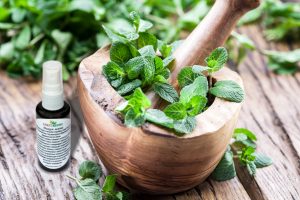
There are many ways to preserve fresh cut mint, it is only important to observe a number of important conditions:
- The presence of dust and dirt on the leaves of the plant is unacceptable. Therefore, before harvesting, you should rinse and cleanse it.
- Direct sunlight negatively affects fresh mint, because of them it loses freshness and useful elements.
- The shelf life can be increased by storing in a room with a lower temperature.
- Strong odors, typical of spices and seasonings, will spoil the mint, as it will absorb foreign odors during storage.
For storage, undamaged, healthy leaves are suitable. The color of the leaves of fresh mint should be rich and uniform, the smell intensifying when rubbed.
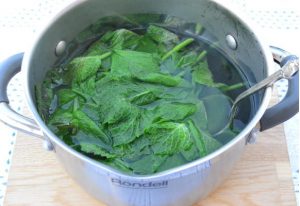
After washing, the crop should be dried without exposure to the sun. If only leaves are sent for storage, then it is at this moment that you need to separate them from the stems.
Fresh mint can be stored in water, plastic, paper towels, or refrigerated. In the first option, cut the mint stalks at an angle to better absorb moisture and place them in a container of water like a bouquet. As such, mint will last longer, but the liquid should be changed every few days to keep it clean. To increase the shelf life, you can use mineral water.
A plastic bag or film will help to increase the life of the plant. The crop is wrapped in polyethylene and stored upright in the refrigerator.
A thick layer of paper towels, slightly dampened with water, also helps keep the mint fresh. Fresh twigs are laid out on them and folded. The main thing is not to wrap it too tight.
A cool place like a basement or cellar can replace the refrigerator. The coolness prolongs the life of the beneficial properties of the plant in a natural way.
Read on:
How to keep the freshness and aroma of cilantro leaves
How to keep arugula leaves fresh and flavorful
How to keep strawberries fresh and flavorful - proven methods
How to keep lettuce fresh for a long time?
Ways to Freeze Mint for the Winter and How You Can Use It
Dried mint - when to harvest and how to dry properly
Previous
Greens and herbsDried mint - when to harvest and how to dry properly
Next
Greens and herbs May nettle - ways to freeze for the winter
Freezing methods
Depending on how and for what the mint will be used in the future, there are several ways to harvest it for the winter.
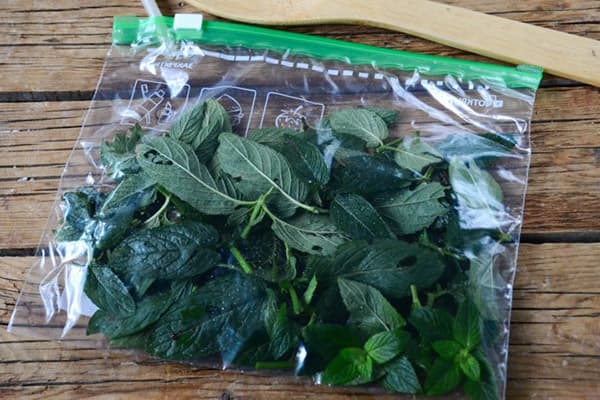
In vacuum bags
Ideally, aromatic herbs should be frozen in this way, because when they stay at low temperatures for a long time, the plants "dry out" - moisture evaporates from their tissues, and with it essential oils, which provide a pleasant smell. If the greens are in a bag from which the air has been removed, the moisture simply has nowhere to go. This means that even after 5–6 months, mint will fully retain its taste and look fresh.

In ice cube trays
This preparation is perfect for cocktails, iced tea. If it is planned that the mint should convey its aromatic and taste notes to the drink, the leaves should be finely chopped, immediately put into molds, filled with drinking water (pure or with the addition of lemon juice) and sent to the freezer. The faster this task is completed, the more essential oils will be retained in the greenery.
In the case when the mint inside the ice cubes is a decoration, it is better to use whole leaves. The tops of the stems look the most beautiful.
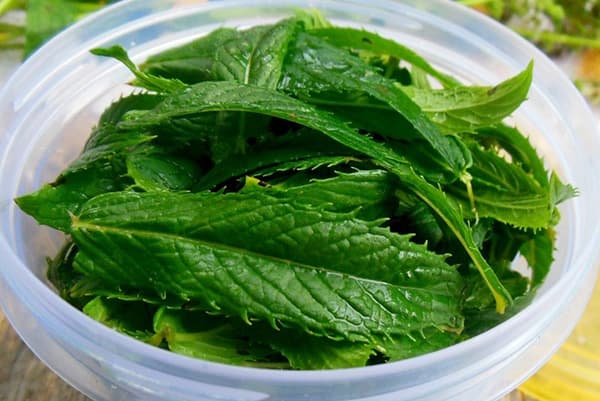
In plastic containers
If you don't have a vacuum dispenser or ice cube trays, you can freeze the mint in a regular plastic container.
It is important to make sure that the operating temperature range is indicated on it: a container that is not intended for use at temperatures below zero degrees can emit harmful substances or simply become unusable
Freezing in a container will prove to be a winning option in the following cases:
- The need to use mint arises often, while a small amount of it is consumed (it makes no sense to open the vacuum bag, and it takes two seconds to open and close the container).
- The estimated shelf life is less than two to three weeks (during this time, the grass will still not have time to lose its aroma and dry out).
A prerequisite for this method is the presence of a sealed cover.
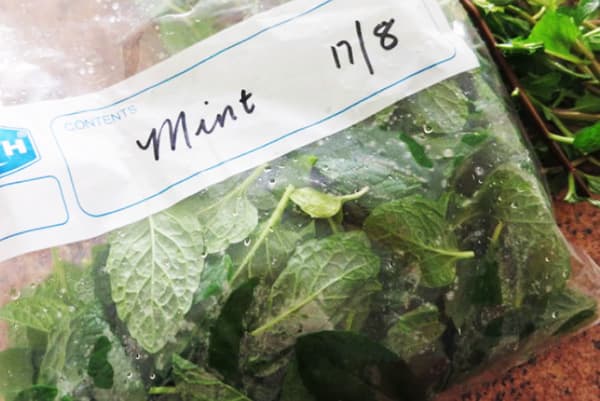
Useful Tips

Harvesting mint for the winter should start with its collection, and then proceed to processing.
The best raw materials for long-term storage can be obtained from two- or three-year-old plants. It is best to harvest in the evenings or in the morning when there is no dew on the plants. Also, the weather should be cool and dry. Mint is best harvested by cutting off about a third of the stem. The fact is that its hard part is not suitable for storage for the winter. Moreover, if left until the end of the season, it can give fresh growth.
When to pick mint for the winter? It is best to start harvesting it in the middle of summer - July or August. In most Russian regions, by this time, mint begins to bloom. It is easy to determine this by lilac-pale or pinkish inflorescences. By this period, a large amount of essential oil accumulates, which is concentrated in the tops of the shoots, flowers and foliage. There are also many other active substances. It is for them that this culture is so appreciated.
A little about useful properties
It is no coincidence that this plant is so in demand - the whole world knows about the beneficial properties of mint.
Since ancient times, mint has been used as one of the main medicinal plants. Its healing properties are recognized by almost any doctor. At the same time, a large number of medicines are made from it.

Peppermint has a diuretic effect. Plain mint tea will flush excess fluids from the body. The harm from consuming large amounts of salt is also leveled with the help of decoctions from this plant.
Safflower, loosestrife, asparagus, ziziphus, hops, lavender, cornflower have a slight diuretic effect.
Did you know? Legend has it that mint got its name from the Roman goddess of reason and common sense Menta.
But the soothing properties of mint have become widely known. A couple of leaves added to regular tea will be enough to put your nerves in order.
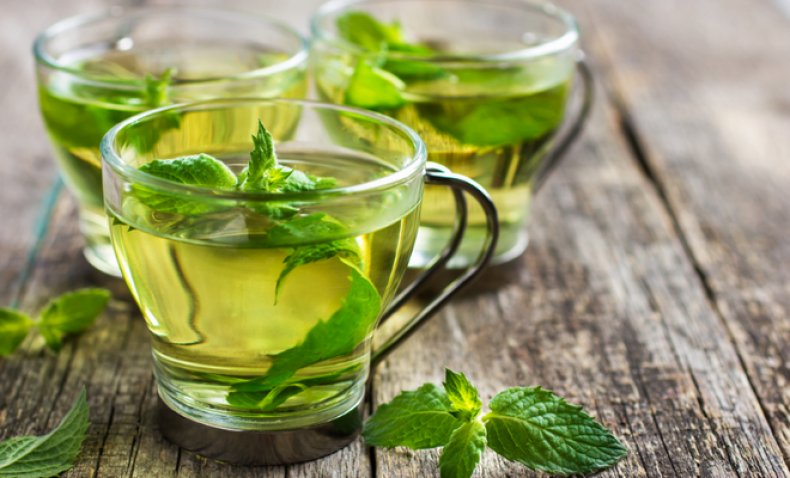
Many anti-inflammatory ointments are made from peppermint. Wild mint is effective for intestinal disorders and flatulence. It is also used against tuberculosis and rheumatism.
Check out the medicinal properties and contraindications of peppermint.
Terms and methods of storage
The shelf life of mint depends on the chosen storage method. For convenience, all information is collected in the table:
| Storage method | Storage periods |
| At room temperature | 2-5 days |
| In fridge | 5-7 days |
| In the freezer | 4-6 months |
| Dried | 1-2 years |
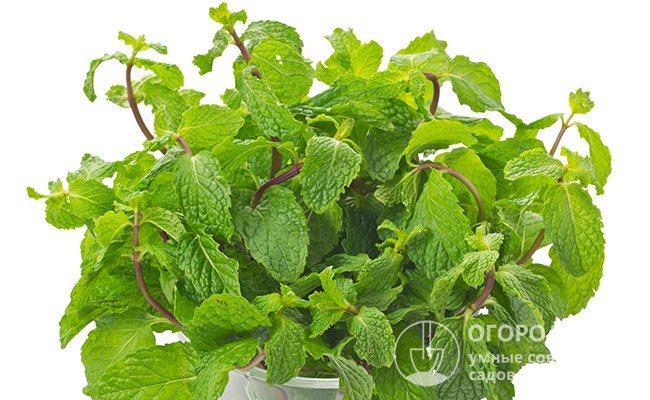 You can store fresh mint for several days in a glass / container with water (do not forget to add water to the container)
You can store fresh mint for several days in a glass / container with water (do not forget to add water to the container)
In fridge
You can keep the mint fresh in the refrigerator. Rinse the grass twigs, shake off the water. Simply wrap the stems in a damp cloth or rag and place in a container or plastic bag. Close the container well to avoid air infiltration. Store mint in the vegetable drawer or on the bottom shelf of your refrigerator.
In the freezer
You can store mint in the freezer. The freezing process is very simple and involves several steps:
- Go through the greens and remove the limp, crumpled and spoiled leaves.
- Wash the twigs well in cool water and then pat dry with a paper towel. If the excess moisture is not removed, the mint will clump together, making it difficult to separate into portions after freezing.
- Place the prepared mint in a plastic bag and place in the freezer.
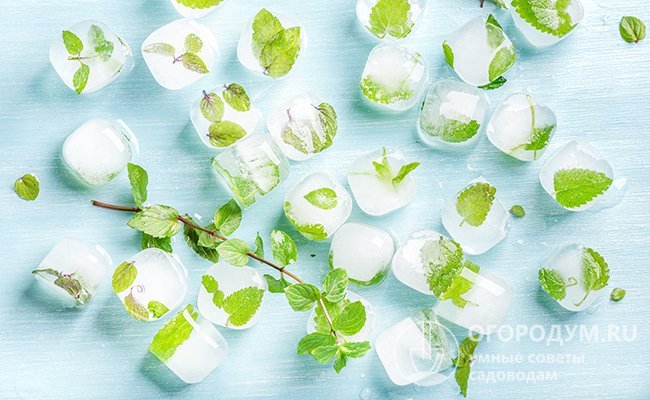 You can save the mint for the winter in the freezer. The frozen blank is suitable for making desserts, alcoholic and milkshakes
You can save the mint for the winter in the freezer. The frozen blank is suitable for making desserts, alcoholic and milkshakes
Freeze mint intended for drinks without stalks, in separate leaves. Place the prepared food in a plastic container and loosen it a little to ensure normal air circulation. This will keep the leaves from sticking together and help keep them appetizing.
Close the lid of the container and send the workpiece to the freezer. This method of keeping mint fresh is used in bars and food service establishments.
There is another popular freezing recipe: cut the mint leaves, put them in the cells of the ice freezer container and fill with boiled water. Place the container in the freezer and store the food there as long as you need it. Add frozen mint cubes to smoothies, tea, or desserts.
Drying
You can preserve the taste and aroma of mint for a long time by drying. For harvesting, collect raw materials in late July - early August. During this period, the herb has the most intense taste and aroma that essential oils provide. The well-known menthol is obtained from the essential oil of mint.
To dry, sort the mint, rinse and dry well with a paper or rag towel. Tie the prepared raw materials into bundles and hang or spread out in a dry, dark place. The main requirements for drying are constant circulation of fresh air, low humidity and no direct sunlight.
After complete drying, grind the leaves, and break the stems. Place the blank in a sealed glass jar or linen bag. Store mint in a dry place.
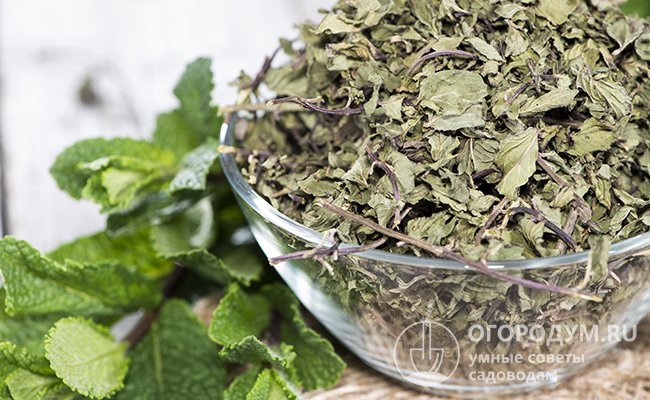 Dried mint retains all its beneficial, flavoring and aromatic properties. It will be an ideal seasoning for soups, meat and main courses. You can store dry mint for as long as possible - within 1-2 years.
Dried mint retains all its beneficial, flavoring and aromatic properties. It will be an ideal seasoning for soups, meat and main courses. You can store dry mint for as long as possible - within 1-2 years.
Growing mint on a windowsill
To always have a fresh sprig of mint on hand, it can be grown at home on a windowsill. Pick a beautiful branch of grass from the garden and place it in a glass of water. The sprout will take root fairly quickly. Transplant the plant into a pot of soil and place it on a windowsill. (Or you can plant a mint bush from the garden, transplant it into a pot and bring it into the house. This is easier, and the plant will take root faster.) Do not forget to water the mint, otherwise it will begin to wither.
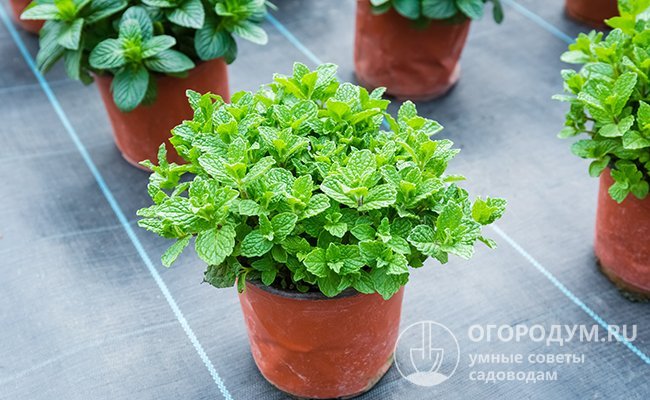 Mint can be grown on a windowsill - this does not require special knowledge or skills, while there will always be a sprig of fragrant spice at hand
Mint can be grown on a windowsill - this does not require special knowledge or skills, while there will always be a sprig of fragrant spice at hand
Mint has a special aroma and taste, it gives food and drinks a hint of piquancy and freshness. In order to be able to use the beneficial and flavoring properties of the plant all year round, take care of preparing the grass for the winter in advance.
Features of drying and storing mint greens
Mint greens, like other spicy herbs, can be dried in modern electric dryers, however, in this case, it is important to remember some of the features of the spicy herbs. How to dry mint so that it retains as much essential oils, vitamins and healing substances as possible? First of all, do not expose raw materials to high temperatures. The optimum temperature for drying herbs is 20–35 ° C
Therefore, the most gentle mode is used in an electric dryer, and it is not recommended to dry mint in the oven for the winter.
On this topic:
BACK
FORWARD
1 of 27
If the room where the bunches of mint are hung is damp, the grass must be moved to another place as soon as possible, otherwise mold will settle on the stems and leaves and make the raw materials unusable.
Dried mint storage rules
Mint with sugar for the winter is often harvested by zealous housewives. This is the best way to add it to tea.
If you just dry it, then at room temperature this must be done for several days. To determine the readiness of a plant, simply press down on its leaf. When it easily separates from the stem and crumbles in your hands, drying can be safely completed. After that, grind the raw materials and pack for long-term storage.
After drying, it is important to store the mint properly. Of course, chopped greens take up little space, but at the same time they lose their color and aroma more intensively.
Therefore, it is best not to grind it into powder ahead of time. And if it comes down to grinding, then do not use a coffee grinder. Use gentle manual methods instead.
Glass jars are best for storage. They must be dry with a tight-fitting lid. So neither moisture nor pests will penetrate inside. In a dry place, herbs will retain their aroma for up to six months.
How to keep mint for the winter
In order for the mint to survive for the winter at home, it must be frozen. There are several ways to freeze, but, in any case, you need to collect mint in the midst of its flowering - late June - early July, during the period when it has the highest level of essential oil.
In order to lay a stock of mint for the winter, you need to rinse it well, dry it with a towel or paper napkins. Mint is folded neatly into a container, leaf to leaf, no need to ram, and put in the freezer. After a few hours, the frozen leaves can be folded more tightly, but this must be done quickly so that the leaves do not begin to thaw. You can store it in the freezer of a regular refrigerator.
You can take leaves and twigs and cut them into strips, put them in a container, close and put them in the freezer.
You can finely chop the mint, put it in an ice container, add water and freeze. The resulting cubes are good for making cocktails.
Drying mint
An old proven method of storing plants is drying. Its use allows you to preserve all the taste, color and menthol odor. There are several drying options:
- natural - in a well-ventilated place;
- using a microwave oven;
- drying in the oven.
Drying in the oven and microwave reduces the preparation time, however, as a result of heat treatment, the product loses a significant amount of useful properties, essential oils simply evaporate during such processing.
Natural air drying allows you to get a truly delightful result, provided that all the requirements of the preparatory stage described above are met.
The rest of the actions will not take much time:
- it is necessary to collect mint in small bunches;
- tie tightly the lower part of the stems with a strong thread or twine;
- hang bunches of mint down in inflorescences so that all substances are concentrated in the leaf area.
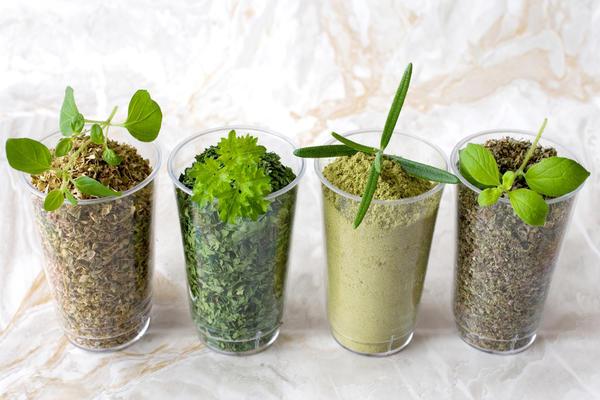
The room should be well ventilated without direct sunlight on the plant.
Such a blank is stored for more than a year without losing its properties. Tea, meat dishes, dessert are the main uses of dried mint.
How to store fresh mint
Mint leaves are distinguished by a thin and delicate integumentary tissue that weakly retains moisture. That is why the cut branches lose their juiciness and wither in 2-3 hours. But how to increase this period in order to enjoy the taste and aroma of mint as long as possible?
The easiest and most common way is to store fresh mint in a container of water, like flowers. It is necessary to cut off the stems obliquely, tear off the leaves at the base and put the branches, for example, in a glass of water. By changing the water daily, you can extend the freshness of the mint up to 3-4 days.
If within 2-3 hours after you plucked (bought) mint sprigs, you will not have a container of water on hand, you can wrap the grass in a damp handkerchief.This will save time and prevent the leaves from withering quickly.
Another way to store fresh mint at home is to place dry twigs in an airtight plastic container, close them tightly and put them in a cool, dark place. Cover the container with a thick cloth to protect the grass from sunlight. The shelf life will be 2-4 days. You can also use a plastic bag, but it is better that it has a fastener and does not allow air to pass through.
If you want to extend the juiciness of the herb to 7-10 days, you can store the mint in the refrigerator. For this, undamaged leaves (bundles) are selected, washed, slightly dried, folded into an airtight container and placed in the vegetable compartment. In the absence of packaging, you can wrap the leaves in a paper towel - this way they will remain juicy for up to 5-7 days.
In the case when the plant has already begun to wilt, you can slow down this process: put the stems in a glass of water and put them in the refrigerator, covered with a plastic bag. Mint will "hold out" for another 3-4 days.
Mint can be preserved for a longer time if it is frozen. The herb is pre-washed, dried, the leaves are selected and folded into a plastic bag (glass jar, foil). Excess air is released from the bag, tied tightly and placed in the freezer. In this form, mint is stored for a long time, it will definitely survive one winter, and in the summer you can stock up on a new crop.
Another interesting way to store mint is in ice cube trays. The leaves are finely chopped, placed in molds and filled with water. The resulting mint cubes are convenient for decorating various cocktails (for example, mojitos) and making teas.
How to use
This plant is appreciated not only for its pleasant rich aroma, but also for the healing properties that traditional healers often used. This is due to the high content of essential oils and tannins. For example, mint tea is good for nausea, heartburn, flatulence. You need to add one tablespoon of the dried plant and pour a glass of hot water. After 10 minutes, you can drink homemade, delicious medicine. It will also help get rid of the symptoms of angina pectoris.
Mint will also be useful for a child when he has skin rashes. It is necessary to carry out bath procedures with the addition of mint broth. Men should not get carried away with tea with this plant, because it can affect the "masculine strength". Mint should not be used by people with low blood pressure due to its vasodilating properties. In all other cases, people are free to enjoy this beautiful plant.
Useful articles from the "Spicy" section:
Useful articles for the gardener:
- Sea buckthorn jam for the winter: recipes
- Planting Brussels sprouts in 2020: timing, cultivation and care
- Florist lunar calendar for 2019
- Lunar calendar for indoor plants for March 2020
- Garden var: how to cook at home and how to use
- How to get rid of aphids on cabbage: how to process, effective methods
- When to dig up gladioli after flowering in 2020: auspicious days
- When to dig out hazel grouses after flowering and how to store them correctly
- Lunar calendar of the gardener and gardener for July 2020: auspicious days
- When to dig up daffodils after flowering in 2020: timing how to store
How to freeze mint?
Preparing mint leaves for storage
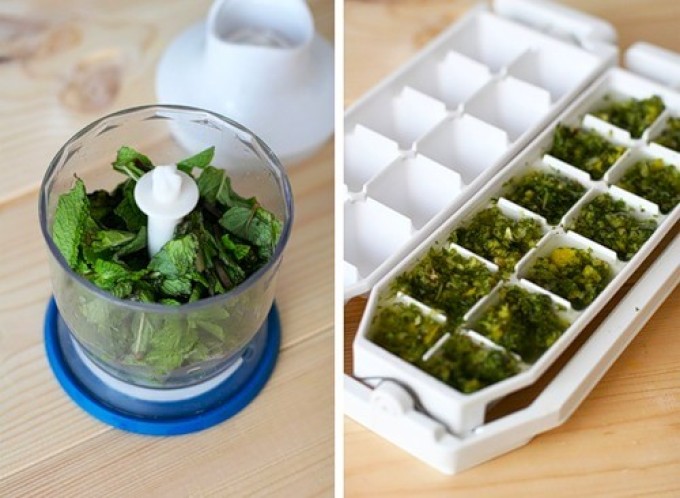
Any mint is suitable for freezing, even different varieties can be used together. To prepare for freezing, follow these steps.
- Pour cold water into a large bowl and put our herb there for a few minutes.
- After that, the shoots need to be rinsed under running water, shake off excess moisture and spread in one layer on a towel, and you do not need to cover it with anything.
- In this position, we leave it for about 30 minutes, during all this time you need to shake off the mint several times, stir it up so that the water evaporates faster.
Do not leave the mint in this position for a long time, otherwise it will wither and will not work for freezing.
Is it possible to freeze mint leaves

Anyone who loves mint has most likely wondered more than once, is it possible to keep the herb fresh for a longer time? And we answer that it is possible. Moreover, there are many ways for this, although freezing remains the most relevant. Thanks to this storage method, it will not only retain its beneficial properties, but also remain fragrant for a long time.
Whole leaf frozen
We select large leaves without spots, damage, aside setting aside the tops and small leaves. We lay out large sheets of paper in plastic containers or small jars. After that, we send the jars to the refrigerator.
It is better not to use a plastic bag, the leaves in it can easily break after freezing.
Shredded leaves

To use this method, you need to separate the leaves from the "trunk" of the mint, and finely chop them. Then transfer the chopped mixture into zip-fastened sachets, release the air from them and close tightly. To make the bags take up less space, you can roll them up and make them compact.
How to freeze mint in foil

Some housewives freeze whole mint twigs at once. After the plant is harvested, it needs to be cleaned and washed. Then place the branches in foil without squeezing the branches and move them to the freezer.
Freezing mint in ice cubes

A similar method of freezing for housewives is considered the most successful. After keeping mint in ice cubes, you can “freeze” all its properties. In this position, it will not break, it will not turn black, and the leaves will not crack from low temperatures.
For freezing, you will need a container for making ice (cubes), drinking water (boiled or still mineral water). Put small mint leaves in an ice cube tray (if necessary, you can break them into small pieces). After that, we fill the cells with water and place them in the freezer (temperature from -18 and below). Once the cubes are frozen, you can pull out the tray, remove the mint ice and transfer to a bag, then repeat the procedure.
Aromatic sugar

For tea, mint can also be preserved with sugar, to which you just need to add this herb. This sweetness can be used for drinks, baked goods, desserts, or fruit salads. Such freezing allows the sugar to be saturated with useful trace elements of mint, and to keep the grass fresh for a long time.
How do you prepare such a mixture? Everything is very simple! Greens and sugar must be taken in equal quantities, and then chopped until smooth. Then put the resulting mixture in clean jars and place in the refrigerator.
How to freeze mint for the winter for a mojito
If your family loves mojitos or other cocktails that contain mint, then you need to freeze the whole leaves of grass. It is advisable to select small, intact leaves that will look much more spectacular in a cocktail glass. Then proceed in the same way as when freezing mint in ice cubes, carefully placing the leaves in a special tray, and after freezing, put them in a plastic bag (best with a zip fastener) and then close tightly.
How to freeze lemon and mint

Freezing mint with lemon is ideal for those who like to drink delicious aromatic tea in winter. To do this, wash the mint and pour over the citrus with boiling water, wash it thoroughly and cut it. Put the mint, chopped lemon into a blender and mix thoroughly. The finished mixture can be transferred either to an ice cube tray or to a jar.
For those with a sweet tooth, sugar can be added to the blender.
How to use frozen mint
Whole frozen mint leaves can be added to compote, tea, soft drinks and alcoholic beverages. Chopped mint can be added to casseroles, soups, curds, or stir-fries.By the way, mint puree goes well with some sauces.
Why dried mint is good for you
The healing properties and contraindications of the plant are due to its chemical composition, which has been studied for a long time. It contains many amino acids, essential oils, resins, organic acids, tannins and minerals, water, phytosterols, fatty acids, terpenes. The herb is rich in vitamins (retinol, group B, nicotinic and ascorbic acids) and largely in micro- and macroelements (magnesium, calcium, sodium, zinc, iron, phosphorus, copper, potassium).
It is one of the most used herbs due to its many beneficial effects. The ancient Romans perfumed banquet halls, they believed that the smell of mint improves brain function and improves memory.
Mint is grown for use as a table tea, which is very beneficial during the fall and winter season. Cold mint tea is a great refreshing drink for warm summer days, and hot mint is a great way to go after overeating.
Menthol oil helps with nausea, abdominal pain, flatulence (gas in the intestines), mint soothes spasms in the gastrointestinal tract, restores appetite
It is important to take a small dose of it in tea. The plant has anti-inflammatory and choleretic effect, is an herb for the treatment of diseases of the biliary tract, cholelithiasis, chronic pancreatitis.
Menthol is also part of many cardiovascular medications.
Mint is used in the treatment of upper respiratory tract with bronchitis, has an antiseptic and analgesic effect.
Traditional medicine believes that mint is an herb for treating dizziness, insomnia, headache, depression, and epilepsy. A decoction of the leaves is used against nervous excitement, gum inflammation and toothache. Peppermint helps eliminate bad breath. To do this, soak mint leaves for 8 days in red wine in a ratio of 1 to 10. Use the resulting mixture for rinsing or drinking (two tablespoons after meals).
Peppermint is a good cure for nausea and hiccups. Acts as a diuretic and is used for difficult and painful urination.
It contains a large amount of vitamins A and C and is recommended for the prevention and treatment of scurvy, improving vision and reducing night blindness, as well as for shining eyes and hair.
Be careful if you are allergic to this herb to avoid inhaling peppermint oil vapor.
Peppermint is widely used in cooking. Adds flavor to fruit salads, especially with strawberries, jams, creams, soft drinks and ice cream. A good combination with a chocolate or alcoholic cocktail.
In addition to the food industry, the herb is also used in cosmetics (an ingredient in perfumes, soaps, toothpastes, and mouthwashes) and aromatherapy. Many people also use mint as a mosquito repellent. They grow it in pots. Menthol oil is an ecological insecticide against wasps, ants and cockroaches.
